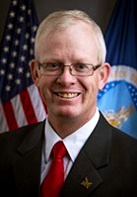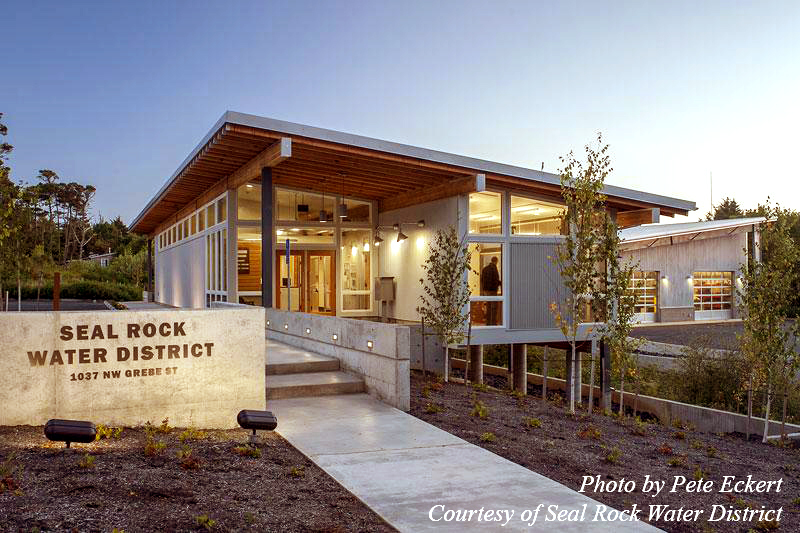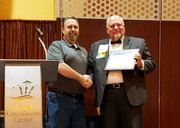|
Welcome to
the quarterly newsletter of USDA Rural Development in Oregon. Here, you will
find updates on funding opportunities and program activities through Business, Cooperative, Energy, Electric, Telecommunications, Water and Environmental, Community Facilities, Multi-Family Housing, and Single Family Housing programs.
Oregon is pleased to welcome Bruce Lammers as the Administrator of Rural Development’s Rural Housing Service and Chad Rupe as the Administrator of the Rural Utilities Service.

Lammers comes to USDA with more than 35 years of experience leading public-private partnerships at national community-oriented lending institutions. Beginning in 2016, he served as President of a specialized government guaranteed lending division of Byline Bank. Prior to this, Lammers was Chairman and CEO of Ridgestone Bank, a national leader in government guaranteed lending.
Lammers has served as a board member of many community organizations, including the National Association of Government Guaranteed Lenders (NAGGL). He looks forward to enhancing his focus on economic development in small towns across America in his new role as USDA Rural Housing Service Administrator.
|

Rupe served as Acting Administrator for the Rural Utilities Service since April 30. Before to stepping into that role, he served as the USDA Rural Development State Director of Wyoming from 2017 to 2019. Prior to being appointed as State Director, Rupe worked in Rural Development’s Community Programs in Wyoming. During his time with the program, Rupe underwrote and managed more than $13 million in Water and Environmental Program direct loans and $4.75 million in grants.
Prior to joining USDA, Rupe spent more than 13 years in the banking industry, specializing in commercial lending in Wyoming. Rupe began his service to our country in the United States Army.
|

We are pleased to welcome a new member of the Oregon Rural Development team! Eric Nerdin is a Community Programs Specialist in the state office.
Eric’s past work experience includes banking (both in lending and management) and small business ownership. He comes to USDA from the Mid-Columbia Economic Development District, where he worked for 11 years as the Loan Fund Manager.
Eric lives in The Dalles with his wife and their 9-year-old daughter. They also have two grown sons.
You can reach Eric at eric.nerdin@usda.gov or (503) 414-3326.
|

We are also pleased to welcome back a former member of our team. Nathan Brown is a Business and Cooperative Programs Specialist in our Tangent office.
He is returning to Oregon after serving as the Business and Cooperative Programs Director for USDA Rural Development in Montana. Nate also has prior experience in USDA’s Single Family Housing programs.
Prior to joining USDA, Nate spent five years as a loan officer and branch manager in the banking industry. He has a Master of Business Administration from the University of Nevada.
You can reach Nate at nathan.brown2@usda.gov or (541) 801-2685.
|
You are invited to join us for an Oregon ReConnect Broadband Workshop to learn about the planning process and resources available to help expand broadband infrastructure in your rural community.
These one-day workshops, designed to inform and engage civic leaders, businesses, and community champions, will feature industry experts and provide:
- A discussion of cutting-edge broadband applications that will reshape our communities and help drive rural prosperity;
- An overview of relevant USDA Rural Development grant and loan programs; and
- An interactive session to support local teams as they evaluate and develop local broadband projects.
These are free events and open to the public. Registrations will be accepted through August 23. Walk-up registrations will be made available as space permits.
Oregon ReConnect Broadband Workshop in Independence
When: Wednesday, August 28, 2019
8:30 am — 3:30 pm
Where: Independence Event Center
555 S Main Street
Independence, OR 97351
Agenda: View the full agenda
Register: https://broadband-workshop1.eventbrite.com
Oregon ReConnect Broadband Workshop in Madras
When: Thursday, August 29, 2019
8:30 am — 3:30 pm
Where: Central Oregon Community College
1170 E Ashwood Road
Madras, OR 97741
Agenda: View the full agenda
Register: https://broadband-workshop2.eventbrite.com
 USDA Rural Development is providing $11.8 million to establish a reliable water source and build infrastructure to treat drinking water for the rural community of Seal Rock on the Oregon coast.
The Seal Rock Water District currently receives treated water from Toledo. The transmission pipe passes through tsunami inundation zones and areas prone to landslides and flooding. After a natural disaster, the line is difficult to access. In recent years, the system has failed several times, requiring costly emergency responses to restore service. In the event of a Cascadia Subduction Zone earthquake, this water source would cease to be available to Seal Rock.
Studies found that the most favorable solution would be to develop the district's own primary water supply from Beaver Creek, for which the district received water withdrawal authorization in 2016.
With the help of a $9.1 million loan and a $2.7 million grant from USDA's Water and Waste Disposal Program, as well as $3.4 million from the State of Oregon, the Seal Rock Water District will install submersible pumps in Beaver Creek and construct a plant that uses membrane filtration to treat the water. The treatment plant will be located above the tsunami impact zone. In addition, the district will build a 500,000-gallon reservoir for water storage. A new water pipeline will be installed, and the new municipal water system will include backup power generators so an electrical outage will not impact service. The facilities will also be designed to promote rapid recovery after a natural disaster, following Oregon's Resiliency Plan.
Overall, this municipal water project will provide a reliable water source and infrastructure that is built to new seismic and tsunami resilience standards, ensuring safe drinking water for this rural community of 4,340 people. Learn more online…
Join Business Oregon on October 20-21 for the state’s first infrastructure summit.
The summit is intended to provide a venue for the exchange of ideas focused around understanding and articulating the interconnectedness of basic infrastructure with community and economic development.
This summit will provide valuable information for city, county, state, and federal decision makers; city, county, and state elected officials; civil and environmental engineers, architects, planners, and construction managers; financial experts; and technology developers.
This is a free event. Register today.
The rural community of Pilot Rock in northeastern Oregon broke ground for its new wastewater treatment facility in June.
Pilot Rock currently depends on a sewer system that began operation more than 60 years ago and can no longer meet modern health and safety requirements.
With the help of $4.3 million in loans and $1.6 million in grants from USDA’s Water and Waste Disposal Program, as well as funding from the Oregon Department of Environmental Quality, Pilot Rock will build a new wastewater treatment facility, including three new lagoons, and install a new pipeline.
Overall, this project will eliminate potential health risks and ensure a sanitary, safe water supply while providing new infrastructure that will serve this community of more than 1,500 people for decades to come.
A community health center recently began construction in the Columbia River Gorge. The nonprofit One Community Health is expanding its Hood River facility to provide additional services and accommodate more patients.
The current clinic was built in 1994 to offer primary medical care to low-income families and migrant and seasonal farmworkers. Since then, the nonprofit has expanded its services to include dental, behavioral health, and enabling services. One Community Health also now hosts a rural family medical residency program. As a result, the nonprofit’s patient base has expanded significantly. Today, One Community Health serves approximately 11,000 patients.
With the help of a $13.2 million low-interest loan provided through USDA’s Community Facilities Program, One Community Health is constructing a new building to increase patient access to medical, dental, enabling, and behavioral services. When complete, the facility will include 20 medical rooms and 18 dental operatories, as well as space to support team-based care and a residency program.
With its expended capacity, One Community Health will help thousands more low-income, rural families and farmworkers from both sides of the Columbia River access affordable, high-quality health care services.
Precision Prefinishing may be a small business, but it needs a large space to custom finish panels for cabinets, siding, and other construction products. Its 130,000-square-foot facility in the rural town of Harrisburg in western Oregon was lit with florescent lights, which contributed to a costly electric bill.
When an electrician told them about a USDA Rural Development grant program to help small, rural businesses make energy efficiency improvements, they decided to apply.
This small, rural business received a nearly $15,500 grant through USDA’s Rural Energy for America Program (REAP). The funding covered one quarter of the cost to replace all lights at the business with high-output LEDs that include proximity sensors to ensure the lights turn off no one is using the space.
"We’re not a big business," said Precision Prefinishing President David Hartmeier, "so knowing we were going to get that funding made it possible for us move forward."
With the new lights installed, this rural business has reduced its energy consumption by about seven percent, which will have a significant impact on its utility bill. The company is expecting to save more than $9,250 a year on electricity, freeing up capital that can be invested in other aspects of the business. Learn more…
USDA Rural Development is seeking applications for financing to establish revolving loan funds to support local economic development.
Through the Intermediary Relending Program, USDA provides low-interest loans to local intermediaries that re-lend to rural businesses. Nonprofits, cooperatives, federally-recognized tribes, and public agencies are eligible to apply. The intermediary may set the rates and terms for loans to the ultimate recipients in amounts sufficient to cover the cost of operating and sustain the revolving loan fund.
Through the Rural Microentrepreneur Assistance Program, USDA provides loans to intermediaries that will in turn provide microloans to support the startup and growth of rural microenterprises. This program can also provide grants to support training and technical assistance provided to microentrepreneurs. Nonprofits, federally-recognized tribes, and institutions of higher education are eligible to apply.
To learn more, contact Eben Fisher, Business and Cooperative Programs Specialist, (541) 278-8049 ext. 129.
The staff who work at apartments funded by USDA Rural Development’s Multi-Family Housing programs guarantee the success of these rental properties. They make sure day-to-day operations go smoothly and help to provide a welcoming environment for the residents. Often, they also invest a great deal of their own time in providing tenants with a safe and cohesive community.
They deserve recognition for their hard work, which is why Rural Development collected nominations from across Oregon and presented awards at the Oregon Affordable Housing Management Association 2019 Annual Conference in Salem.

We are proud to announce that Kevin Poe with Viridian Management was selected as the Site Manager of the Year. Poe received this award for making extensive improvements to the operation of Beaver State Apartments and for his help training other managers of USDA-financed apartments.
|

Congratulations also to our Multi-Family Housing Maintenance Person of the Year! Nicholas Mower with Guardian Management was nominated by tenants of Orchards Plaza Apartments for always going above and beyond the call of duty.
|
 In rural markets, nonprofits play a vital role in efforts to preserve affordable USDA-financed rental housing. As apartment complexes pay off their USDA Multi-Family Housing loans and exit the program, they become ineligible for USDA rental assistance. Transferring the properties through USDA’s Housing Preservation and Revitalization Demonstration Program helps to maintain these affordable apartments for low-income rural residents.
Through a pilot program, additional flexibilities are available for nonprofits to help them better utilize the Housing Preservation and Revitalization Demonstration Program. This pilot program is intended to ensure nonprofits interested in acquiring and retaining affordable rural rental housing have additional resources to help accomplish that goal.
The pilot program has been extended for another two years and updated to make it easier for nonprofits to preserve rural rental housing. In particular, a two-step transfer process is now available to reduce the up-front investment required.
Learn more about the updated pilot program in the June 14, 2019, Rural Development Unnumbered Letter. You can also track the distribution of Rural Development affordable apartment complexes and those scheduled to exit the USDA program when their loans mature using the USDA Multi-Family Housing Property Preservation Tool.
Every time the south winds blew through the Confederated Tribes of the Umatilla Indian Reservation (CTUIR), Mary and Abbie Van Pelt had problems with their roof. Each time, Abbie would climb on the roof to try and fix the issue.
When CTUIR received a Housing Preservation Grant from USDA Rural Development, the tribe’s Housing Department began offering up to $6,000 per household to help tribal elders address health and safety hazards in their homes. When the Van Pelts heard about the grants, they decided to apply and were quickly approved.
The shingles on the Van Pelts’ roof have now been replaced. Their home’s septic system was repaired as well, and they had just enough funding left to replace failing light fixtures and the smoke alarms in their home.
The Van Pelts aren’t alone. In all, 29 families on the reservation are making critical repairs to their homes with the help of this and one previous USDA grant. Eliminating these safety issues is enabling tribal elders to age in place, remaining in the homes they have known for many years. Learn more…
Owning a home not only helps families build long-term financial stability, it also creates jobs, promotes community vitality, and stimulates the local economy. By offering low-interest loans with no down payment required, as well as loan guarantees and grants, USDA Rural Development’s Single Family Housing programs can help rural residents buy, build, or repair a home when they are unable to qualify for conventional financing or cannot afford the higher costs of a traditional loan.
During National Homeownership Month in June, we celebrated the rural families across the West that have achieved the American dream with help from USDA financing. Watch this short video to learn more. And contact a local staff member to find out if USDA can help you take the leap into homeownership.
|